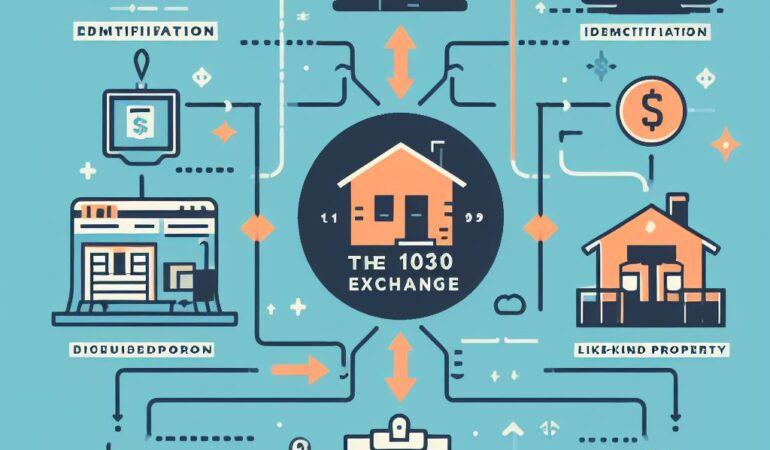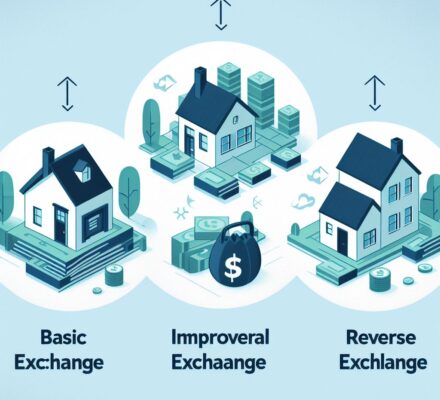Are you tired of paying hefty taxes on your real estate transactions? Look no further!
Our step-by-step guide will show you how to navigate the 1031 Exchange process, allowing you to defer those taxes and grow your real estate portfolio.
Identify eligible properties, select a qualified intermediary, and complete the exchange within the specified timelines.
With our expert advice, you’ll maximize your tax savings and take control of your financial future.
Don’t let taxes hold you back – start your journey to tax deferral today!
Key Takeaways
- A 1031 exchange allows for tax deferral on property transactions, known as a like-kind exchange.
- Thorough research and guidance from professionals are essential for identifying eligible replacement properties for the exchange.
- Initiating the exchange involves entering into a written agreement with a qualified intermediary (QI) who holds the funds and sells the relinquished property.
- Meeting the required timelines and following the steps is crucial to successfully completing the exchange and maximizing tax savings and portfolio growth.
Understanding the 1031 Exchange Process
To understand the 1031 exchange process, you need a clear grasp of the intricacies involved in deferring taxes on property transactions. A 1031 exchange, also known as a like-kind exchange, allows you to sell an investment property and reinvest the proceeds into another property while deferring the capital gains taxes. This tax deferral strategy can be a powerful tool for real estate investors looking to grow their portfolios without the burden of immediate tax liabilities.
The first step in the 1031 exchange process is to identify a replacement property within 45 days of selling your relinquished property. This identification must be done in writing and submitted to a qualified intermediary, who’ll hold the funds from the sale until the new property is purchased. It’s important to note that the replacement property must be of equal or greater value than the relinquished property to fully defer the capital gains taxes.
Once the replacement property is identified, you have 180 days from the sale of the relinquished property to close on the purchase of the replacement property. During this period, it’s crucial to work with a qualified intermediary and other professionals to ensure compliance with the IRS regulations surrounding 1031 exchanges.
Identifying Eligible Properties for Exchange
Now that you have identified a replacement property within 45 days of selling your relinquished property, it’s time to move on to the next step in the 1031 exchange process: identifying eligible properties for exchange.
This step is crucial as it determines the properties that meet the requirements for a successful exchange. Here’s a step-by-step guide on how to identify eligible properties:
- Research: Start by conducting thorough research on potential replacement properties. Look for properties that align with your investment goals and meet the 1031 exchange criteria.
- Consult Professionals: Seek guidance from qualified professionals such as real estate agents, tax advisors, and attorneys who specialize in 1031 exchanges. They can provide valuable insights and help you navigate the complexities of the process.
- Consider Location: Evaluate the location of the properties you’re interested in. Make sure they’re within the United States and meet the requirements for like-kind exchange.
- Review Financials: Analyze the financial aspects of the properties, including their income potential, expenses, and growth prospects. Ensure that they’re a suitable investment for your portfolio.
Initiating the Exchange and Selecting a Qualified Intermediary
Once you have identified eligible properties for exchange, the next step in the 1031 exchange process is to initiate the exchange and select a qualified intermediary. A qualified intermediary (QI) is a third-party entity that facilitates the exchange by holding the funds from the sale of the relinquished property and then using those funds to acquire the replacement property on your behalf.
To initiate the exchange, you must first enter into a written agreement with the QI. This agreement, known as the exchange agreement, outlines the terms and conditions of the exchange and designates the QI as the intermediary. It’s important to select a reputable and experienced QI to ensure compliance with the 1031 exchange rules and regulations.
Once the exchange agreement is in place, you’ll transfer the relinquished property to the QI. The QI will then sell the property and hold the proceeds in a segregated account, ensuring that you don’t have actual or constructive receipt of the funds. These funds will be used to acquire the replacement property within the designated timeframes outlined in the 1031 exchange rules.
Choosing a QI is a critical step in the 1031 exchange process. Make sure to do your due diligence, ask for references, and consider their experience and expertise in facilitating exchanges. Working with a qualified intermediary will help ensure a smooth and successful exchange while maximizing your tax deferral benefits.
Completing the Exchange and Meeting the Timelines
After selecting a qualified intermediary and initiating the exchange, it’s crucial to complete the exchange and meet the required timelines. Failing to meet these timelines can result in disqualification of the exchange and potential tax consequences.
Here are the steps you need to follow to successfully complete the exchange:
- Identify replacement property within 45 days: Once the relinquished property is sold, you have 45 days to identify potential replacement properties. Be sure to adhere to the identification rules and consult with your qualified intermediary to ensure compliance.
- Enter into a purchase agreement: Once you have identified replacement properties, you must enter into a purchase agreement within the 45-day identification period. This agreement should include the necessary language to satisfy the requirements of a 1031 exchange.
- Close on the replacement property within 180 days: From the date of the sale of the relinquished property, you have 180 days to close on the replacement property. It’s important to work closely with your qualified intermediary and other parties involved to ensure a smooth closing process.
- Notify your qualified intermediary: Throughout the process, it’s essential to keep your qualified intermediary informed of all transactions and timelines. They’ll assist you in coordinating the exchange and ensure compliance with IRS regulations.
By following these steps and meeting the required timelines, you can successfully complete your 1031 exchange and enjoy the benefits of tax deferral.
Remember to consult with a qualified tax professional for personalized advice and guidance throughout the process.
Maximizing Tax Savings and Growing Your Real Estate Portfolio
To maximize your tax savings and grow your real estate portfolio, it’s important to strategically leverage the benefits of a 1031 exchange. This powerful tax-deferral strategy allows you to defer capital gains taxes on the sale of investment properties by reinvesting the proceeds into like-kind properties. By doing so, you can reinvest the full amount of your sale proceeds into new properties, providing you with more buying power and potential for future growth.
One key advantage of a 1031 exchange is the ability to defer taxes that would otherwise eat into your profits. By deferring these taxes, you can reinvest the full amount into new properties, allowing your portfolio to grow at a faster rate. Additionally, you can defer taxes indefinitely by continuously reinvesting in like-kind properties through subsequent 1031 exchanges.
To maximize your tax savings even further, consider employing strategies such as diversification and consolidation. Diversification involves investing in different types of properties and locations, spreading your risk and potentially maximizing returns. Consolidation, on the other hand, involves exchanging multiple smaller properties for a larger, more valuable property, which can provide economies of scale and increased cash flow.
Frequently Asked Questions
What Are the Potential Risks and Challenges Associated With a 1031 Exchange?
You may face potential risks and challenges with a 1031 exchange. It’s important to be aware of these to make informed decisions. These include identifying suitable replacement properties, meeting strict deadlines, and managing tax obligations.
Can a Vacation Property or Second Home Be Exchanged Under a 1031 Exchange?
Yes, you can exchange a vacation property or second home under a 1031 exchange. However, there are specific rules and requirements that must be met in order for the exchange to qualify for tax deferral.
Are There Any Limitations on the Number of Properties That Can Be Exchanged in a 1031 Exchange?
You can exchange multiple properties in a 1031 exchange, but there may be limitations. It’s like juggling with tax benefits, carefully considering the rules and regulations to ensure a successful exchange without dropping the ball.
What Happens if the Replacement Property Identified Is Sold Before the Exchange Is Completed?
If the replacement property is sold before completing the exchange, you may not qualify for tax deferral. The IRS requires you to identify and close on a replacement property within certain timelines to avoid this situation.
Can a 1031 Exchange Be Used for International Properties?
Yes, a 1031 exchange can be utilized for international properties. However, there are specific rules and regulations that must be followed, so it is advisable to consult with a tax professional.




